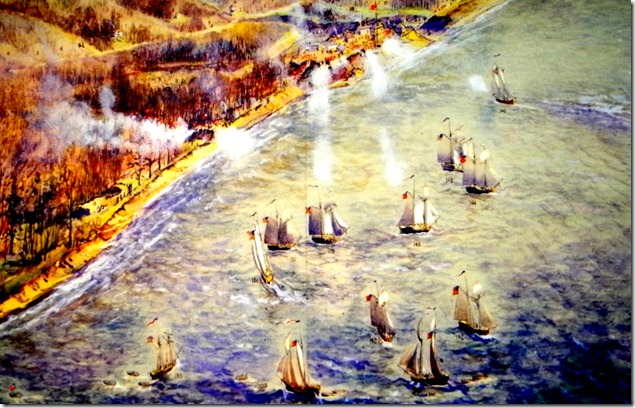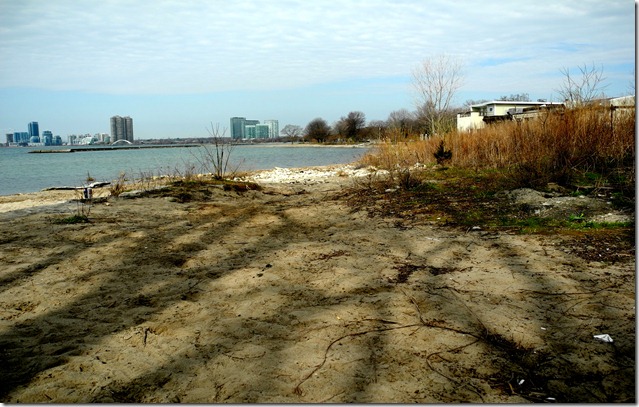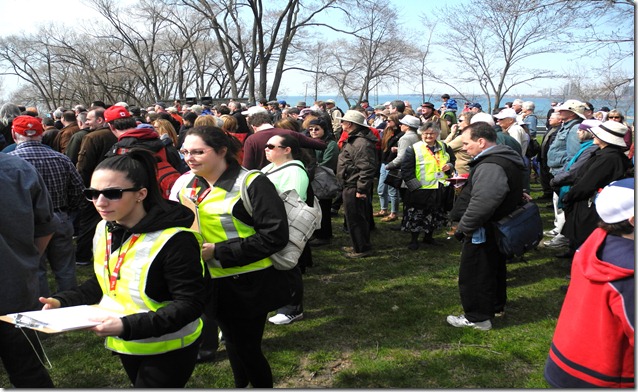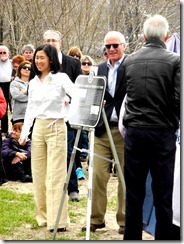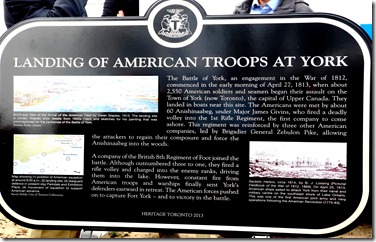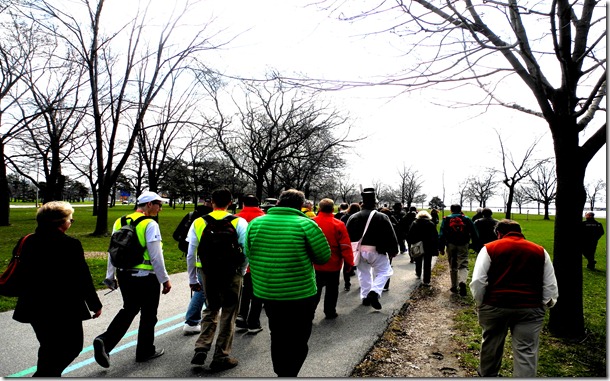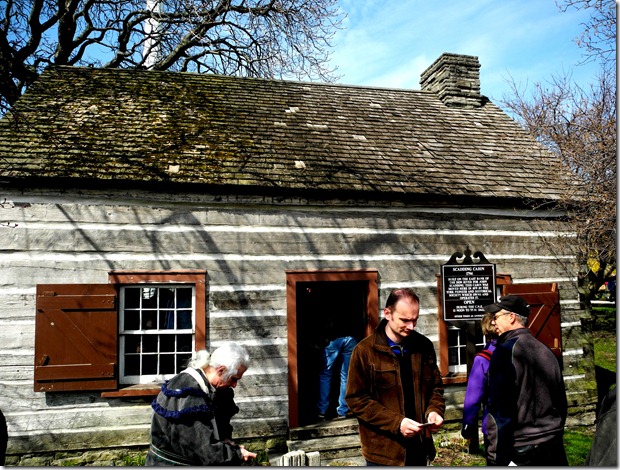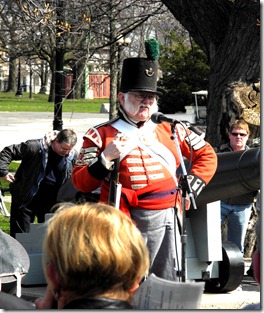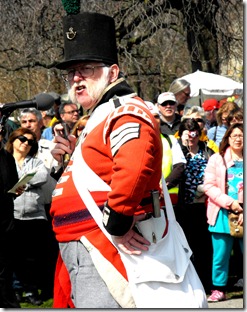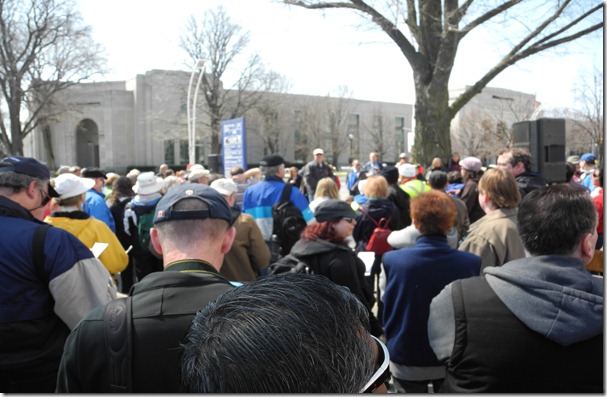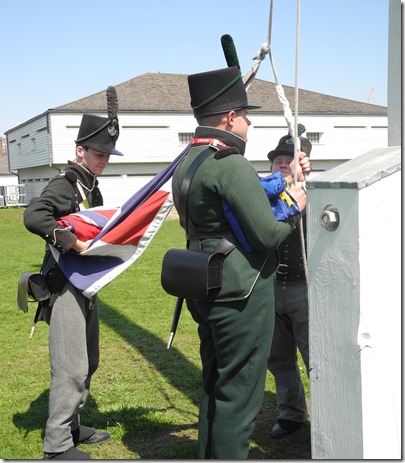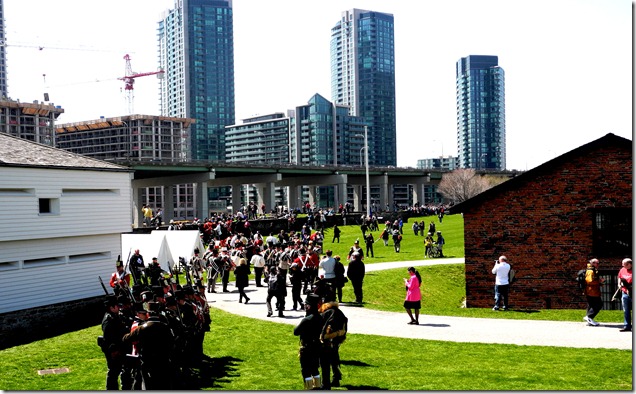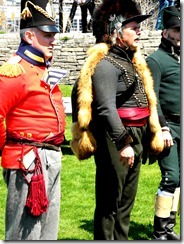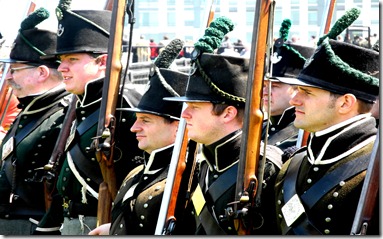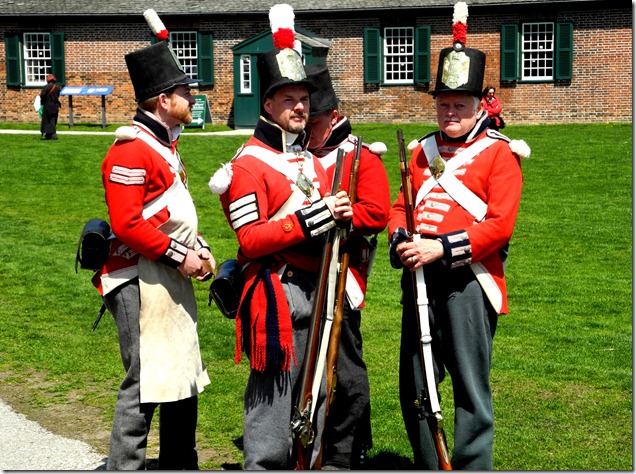On April 27, 1813, a fleet of 14 sailing ships, containing 2500 men, appeared off the shore, west of the small town of York. The War of 1812 had now been dramatically brought to the small settlement of York, which consisted of about 700 persons, their homes located at the far eastern end of Toronto harbour. The photo of the above watercolour is from the Toronto Interpretive Centre, site of Upper Canada’s (Ontario’s) first Parliament Buildings. In 1813, before April 27th ended, these brick buildings would be torched.
This is the site today, where the Americans came ashore on the morning of April 27, 1813. The shoreline is now further away from the lake than it was in 1813, due to landfill. The embankment that skirted the narrow beach has also disappeared. To celebrate the 200th anniversary of the invasion, crowds gathered on the 200th anniversary of the invasion, 27 April 2013, to commemorate the event. The 5 km-walk included five stops where the participants listened to stories about the battle that occurred near where the stops were situated. Loud-speakers allowed the interpretive speakers to be clearly heard.
A portion of the crowds that gathered to commemorate the 200th anniversary of the Battle of York.
A plaque was unveiled close to the place where the Americans came shore. John Moore, host of CFRB “Moore in the Morning,” who attended the walk and introduced it, stated that Canadians are likely the only people in the world who would gather to commemorate a battle that they lost.
As the morning progressed, the size of the crowds grew. They followed the path that the Americans travelled as they proceeded from the landing site toward their target at Fort York.
Scadding cabin was opened for the day to permit visitors to inspect the interior of Toronto’s oldest existing habitation. Built in 1794, it was relocated to the Exhibition grounds in 1879.
One of the interpreters who provided fascinating details and stories of the fighting during the Battle of York.
People gather near the Princes’ Gates to hear about the explosion of the western battery, which eliminated the last defense protecting Fort York from the invading Americans.
Fort York was the final stop on the 5 km walk. The crowds listened intently at they heard about the explosion of the powder magazine located inside the fort. It contained 300 barrels of gunpowder (30,000 pounds). Thirty-eight of the advancing Americans were killed, including their commander, General Pike. Over 200 American soldiers were wounded. The Americans looted the town of York and set aflame the brick Parliament Buildings. When British forces attacked Washington the following year, in retaliation, they set fire to the presidential mansion. Whitewash was applied to the walls of the mansion to hide the effects of the burning and the resulting smoke. The house has been known ever since as “The White House.”
Fort York was opened to the public for the day, with no entrance fee. Visitors mingled with men and women dressed in 19th-century military uniforms.
It was a glorious sunny day, excellent for a walk along the Toronto’s lakeshore and a chance to learn about the city’s history. It was approximately 1 1/2 hours in length.
Heritage Toronto is offering another tour related to the War of 1812 on Sunday, June 2 at 1 pm. It begins at the main(west) entrance of Fort York. There is no charge for the tour. For further information on this and other tours www.heritagetoronto.org
To view the Home Page for this blog: https://tayloronhistory.com/
To view other posts about Toronto’s past and its historic buildings:
Toronto’s first cemetery and monument to those who served in the War of 1812
Toronto’s historic cathedral spires
https://tayloronhistory.com/2013/04/25/torontos-architectural-gemscathedral-spires/
Toronto’s vanishing 19th-century store fronts.
The Art Deco bus terminal at Bay and Dundas Streets.
Photos of the surroundings of the CN Tower and and the St. Lawrence Market in 1977
The old Dominion Bank Building at King and Yonge Street
The Canada Life Building on University and Queen Street West.
Campbell House at the corner of Queen Street West and University Avenue
A study of Osgoode Hall
https://tayloronhistory.com/2012/04/12/enjoying-torontos-architectural-gems-osgoode-hall/
Toronto’s first City Hall, now a part of the St. Lawrence Market
Toronto’s Draper Street, a time-tunnel into the 19th century
The Black Bull Tavern at Queen and Soho Streets, established in 1822
History of the 1867 fence around Osgoode Hall on Queen Street West at York Street
Gathering around the radio as a child in the 1940s
The opening of the University Theatre on Bloor Street, west of Bay St.
https://tayloronhistory.com/2012/02/24/the-opening-of-torontos-university-theatre-on-bloor-street/
122 persons perish in the Noronic Disaster on Toronto’s waterfront in 1949
Historic Victoria Memorial Square where Toronto’s first cemetery was located, now hidden amid the Entertainment District
https://tayloronhistory.com/2012/01/09/victoria-square-in-torontos-entertainment-district-is-a-gem/
Visiting one of Toronto’s best preserved 19th-century streets-Willcocks Avenue
The 1930s Water Maintenance Building on Brant Street, north of St. Andrew’s Park
Toronto’s architectural gems-photos of the Old City from a book published by the city in 1912
Toronto’s architectural gems in 1912
https://tayloronhistory.com/2012/12/04/torontos-architectural-gems-in-1912/
Toronto’s architectural gems – the bank on the northeast corner of Queen West and Spadina
https://tayloronhistory.com/2012/12/02/torontos-architectural-gemsbank-at-spadina-and-queen-west/
Photos of the surroundings of the CN Tower and and the St. Lawrence Market in 1977
The St. Lawrence Hall on King Street
https://tayloronhistory.com/2012/04/28/enjoying-torontos-architectural-gems-the-st-lawrence-hall/
Toronto’s streetcars through the past decades
https://tayloronhistory.com/2012/03/26/memories-of-torontos-streetcars-of-yesteryear/
History of Trinity Bellwoods Park
https://tayloronhistory.com/2012/04/09/the-history-and-beauty-of-trinity-bellwood-park/
A history of Toronto’s famous ferry boats to the Toronto Islands
